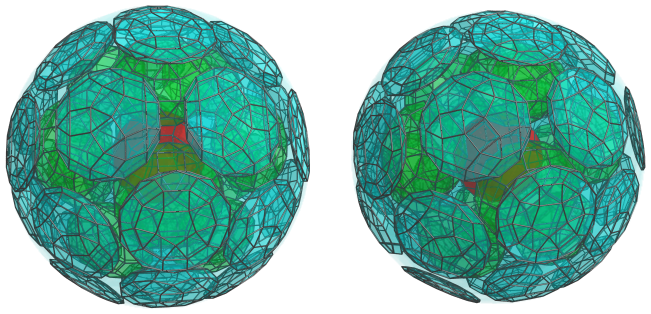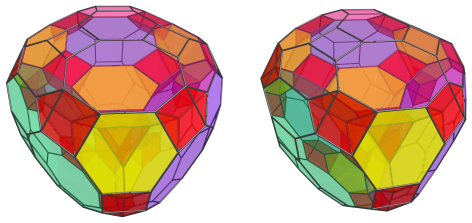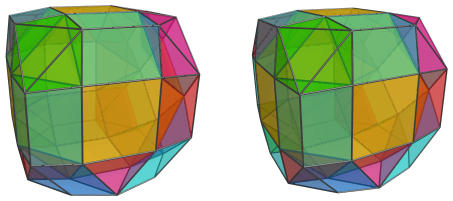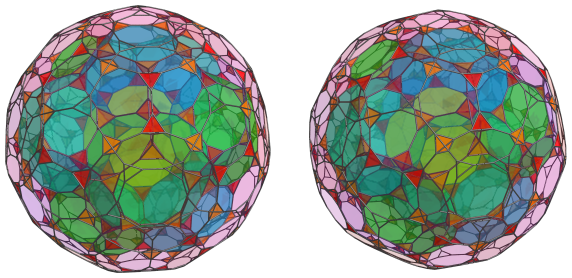4D Euclidean space
News Archive
June 2013
We apologize for the hiatus; Real Life intervened and we were not able to finish the Polytope of the Month for April on time. Nevertheless, it's better late than never, so allow us to present the Polytope of the Month for June (belatedly for April):
This beautiful uniform 4D polytope has an intricate surface consisting of 120 rhombicosidodecahedra, 720 pentagonal prisms, 1200 hexagonal prisms, and 600 truncated tetrahedra. It has 7200 vertices, a whopping 18000 edges, 13440 faces, and a total of 2640 cells. It belongs to the 120-cell/600-cell family, and so shares the same beautiful symmetries. So head on over to the runcitruncated 600-cell page where we explore its structure in detail, accounting for all of its 2640 cells.
As is customary, we provide full coordinates for this beautiful polychoron.
12 Jun 2013:
The Polytope of the Month for April is finally now up. We apologize for the delay.
March 2013
This month, we return to the uniform polychora. Allow us to introduce:
... the cantitruncated tesseract, a beautiful polytope bounded by 8 great rhombicuboctahedra, 32 triangular prisms, and 16 truncated tetrahedra.
This polytope is the last in the tesseract family of uniform polytopes to be added to this site. With this, we now have complete coverage of all the 4D uniform polytopes in the 5-cell, tesseract, and 24-cell families. In a few more months, we will wrap up the 120-cell family, and the coverage of the convex uniform polychora will finally be complete! Stay tuned!
1 Mar 2013:
The Polytope of the Month for March 2013 is up!
February 2013
We take another excursion this month from the usual fare of uniform polychora, to the wild and exciting world of CRF polychora, the 4D analogues of the Johnson solids. Introducing:
The biparabigyrated cantellated tesseract!
This is the half-brother of the cantellated tesseract, obtained by gyrating four segments of the latter by 45°, such that the eight rhombicuboctahedra are transformed into elongated square gyrobicupolae (J37's) (also known as pseudo-rhombicuboctahedra), and 12 of the octahedra are split into square pyramids.
Find out more at the biparabigyrated cantellated tesseract page! As is customary, we provide full Cartesian coordinates for this irregular yet pretty polytope.
26 Feb 2013:
Fixed wrong coordinates for the truncated tetrahedron. We apologize for the mistake!!
24 Feb 2013:
Added the Cartesian coordinates of the cantitruncated 5-cell. Apparently we overlooked this when it was first posted as the Polytope of the Month a while ago!
4 Feb 2013:
Added the square magnabicupolic ring, a CRF polychoron that relates the biparabigyrated cantellated tesseract, the cantellated tesseract, and the 8,8-duoprism.
3 Feb 2013:
Based on Dr. Richard Klitzing's suggestion, we have renamed the polytope of the month, previously dubbed the paratetragyrated cantellated tesseract, to the more accurate biparabigyrated cantellated tesseract.
1 Feb 2013:
The Polytope of the Month for February is up!
January 2013
To start off this year, we introduce another member of the beautiful 120-cell/600-cell family of uniform polytopes:
This is the truncated 120-cell, a pretty polychoron bounded by 120 truncated dodecahedra and 600 tetrahedra.
Continuing with our recent custom, we provide projections of this pretty polytope as cross-eyed 3D stereograms. We highly recommend that you learn how to view cross-eyed stereograms to get the maximum effect from these projections.
As usual, full Cartesian coordinates are provided for this polytope, in algebraic form.
7 Jan 2013:
Added the square cupola, the 4th Johnson solid.
2 Jan 2013:
Added the elongated square gyrobicupola, the 37th Johnson solid.
1 Jan 2013:
The polytope of the month for January is up!
We apologize for missing last month's update; due to other commitments, we were not able to get the polytope of the month ready on time for December. So we are posting it as January's polytope of the month instead.








